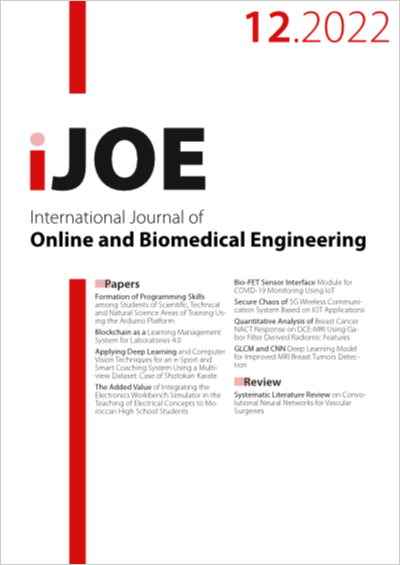Bio-FET Sensor Interface Module for COVID-19 Monitoring Using IoT
DOI:
https://doi.org/10.3991/ijoe.v18i12.31877Keywords:
Bio-FET, Internet of Things, COVID-19, biosensor, CloudAbstract
Rapid transmission of the coronavirus disease via droplets and particles has led to a global pandemic. Expeditious detection of SARS-Cov-2 RNA in the environment is attainable by using Bio-FET sensors. This work proposes a Bio-FET sensor interface module with IoT implementation to amplify signals from a Bio-FET for SARS-Cov-2 detection and monitoring. The sensor interface module was programmed to read the signals using a micro-controller and process information to determine the presence of SARS-Cov-2. The proposed Bio-FET sensor interface module was also set to transmit data to the Cloud via W-Fi to be stored and displayed on a dashboard. The prototype Bio-FET sensor interface module was simulated in PSpice for signal amplification, and hardware implementation has been done by using low-cost components for data transmission to the Cloud. The hardware consists of an AD620 instrumentation amplifier module, voltage sensor module, Neo-6m GPS sensor module, an OLED display, and an ESP8266-32 bit micro-controller. The results of both the simulation and the hardware implementation are similar. The emulated negative and positive Bio-FET signal outputs were successfully amplified from 15.9mV and 45.8mV to 1.59V and 4.58V, respectively, using an AD620 instrumentation amplifier. The gathered location, time, date, output voltage, and SARS-Cov-2 presence results were successfully stored and displayed on the Cloud dashboard.
Downloads
Published
How to Cite
Issue
Section
License
Copyright (c) 2022 Govind Maniam, Ir. Dr. Jahariah Sampe, Dr. Rosmina Jaafar, Prof. Dr. Azrul Azlan Hamzah, Prof. Dr. Noraziah Mohamad Zin

This work is licensed under a Creative Commons Attribution 4.0 International License.


